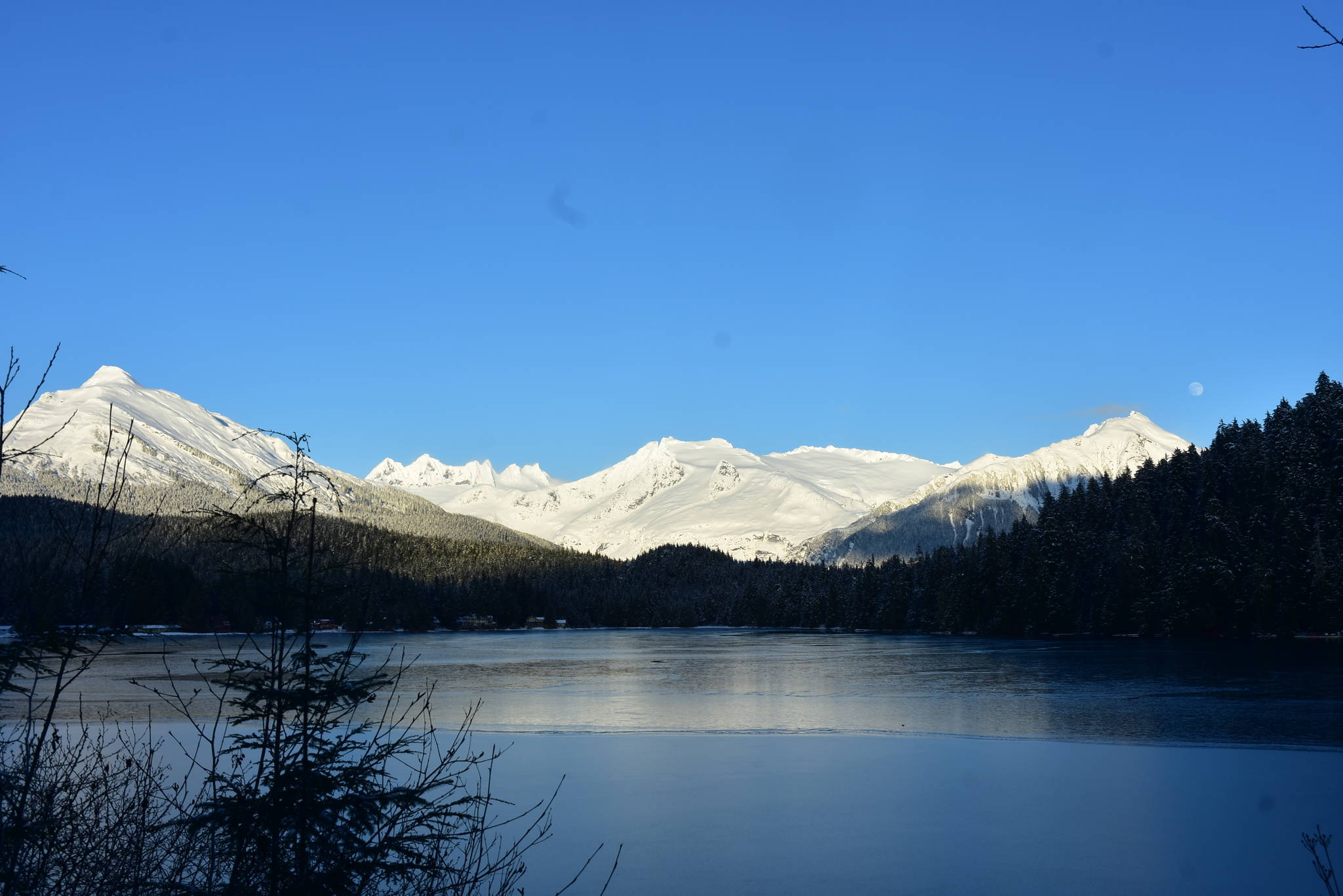By Mary F. Willson
For the Juneau Empire
Back in mid-January, during all that unseasonably warm and dreary weather, I looked out my front window one afternoon, to check on the twenty or so mallards that were congregating on the nearly ice-free pond. An adult male goshawk paraded along the bank, looking meaningfully at the ducks. The wary ducks had retreated to the center of the pond, where they waited to see what the predator would do. Perhaps they felt safer on the water than in the air. Darkness fell before I could observe the end of the stand-off.
In a recent essay, I was moaning about that dismal weather that seemed to last forever, and I was looking for something cheerful to think about. But—wonder of wonders—a few days after I wrote that essay, a big moon appeared in the night sky and a bright yellow orb peeped over the mountains and the sky was blue instead of gray.
Moreover, there was a nice blanket of new snow that added to the welcome brightness. Hurray
[On the Trails: Focusing on the light]
Just before the sun really decided to reappear, we made a tour of the lower loop at Eaglecrest, finding the best assemblage of critter tracks we’d seen for a long time. A few hares had been out and about, and a weasel had bounded across the trail and into the brush in several places. Squirrels had made their usual highways out from the bases of trees. A mouse (probably) had ventured cross a small opening between two brushy shelters. Another set of obscured tracks were a puzzlement: I wanted them to belong to a marten. There were deer tracks in several places, including those of a very small one. The best finding was the wandering track way of a grouse (or ptarmigan), maybe searching for fallen seeds of for buds to nip and eventually disappearing into a thicket.
On a day of full sun, we visited a meadow out the road, plonking about on snowshoes in search of whatever might be interesting. The snow was too crusty for shrews to leave their delicate traceries and voles were staying under the snow, but weasels had been exploring. A deer had come into the meadow and circled several small spruces, pausing here and there. It looked like lichens were on the menu, one kind in particular. Where the deer had been foraging, the spruces still held loads of Usnea longissima (old man’s beard) but little or no Alectoria (witch’s hair). But in parts of the meadow not recently visited by this deer, we could find draperies of Alectoria on the low branches. On other forays, I’ve seen neat browse lines along the edge of the woods, where all the Alectoria had been eaten. Now, I have to wonder what makes that lichen a preferred food (at least at times).
[On the Trails: Truly taking in the scenery]
One morning I headed out for a sunny walk on the west-side beach of Mendenhall Lake. Up at my mailbox I heard a ruckus in one of the trees overhead. There was a tight little ball of about four chickadees, fluttering and flapping and chattering, as they all tumbled from one branch to another. The fight continued down the slope and out of sight. One more thing to wonder about; this was more than a quick argument over a seed or two. Were they picking on an intruding stranger? Or had one of them seriously misbehaved in some socially unacceptable way? Or something else?
On another nice day, my foray took me to another meadow where the tussocks were separated by narrow channels that had been full of water; a layer of ice had formed on the surface. But the channels had dried up, leaving an air-space about a foot deep between the persistent ice and the bottoms of the channels. The snow cover made it hard to tell where the little channels were, so when a snowshoe found one and broke the ice, I dropped down catastrophically and pitched over in a heap. My ‘”feet” were 25 inches long and tangled unmercifully in the remaining ice layer as I tried to extricate myself, so it took a while for me to heave myself up on something solid. Eventually, I wearied of more falls and many near-misses and decided to bail out by walking under some big spruces, where there were no tussocks and empty channels to contend with. These lovely spruces were open-grown, so they had many long, low, sweeping branches for me to clamber over and under, making sure my big ‘feet’ didn’t get snagged. This was hard work too, but there was a little surprise: many of those long, low branches were decorated with a series of small mounds of cone scales, a few inches apart, as the squirrel had chosen a different spot on the branch for each spruce cone on which it snacked, rather than peeling off the scales into one big midden.
• Mary F. Willson is a retired professor of ecology.“On The Trails” appears in the Juneau Empire every Wednesday.

